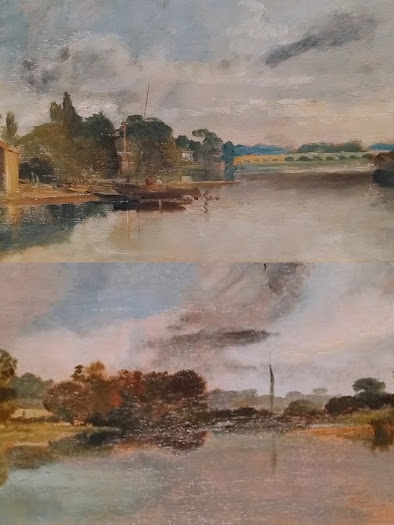Landschap is a Dutch word that translates to
"landscape" in English. It refers to the physical features of a
specific area of Earth's surface, both biological composition and physical
environment [schap = shaping, or condition]. This word was first used by Dutch painters in the late 16th
century to describe paintings of rural or natural scenery. The word landscape was first recorded in English in 1598 and comes from this
Dutch term.
Everybody wants to have a Turner show at the minute, and I have to say that for what is really just a provincial museum out in the sticks, NCM has excelled itself. They have brought together 4 paintings and 9 sketches, alongside other works which have influenced him, or been influenced by him, in a carefully curated exhibition.The banner on the NCM website shows this beautifully. Cornfields and Dunes [Ruisdael, 1660s], Walton Bridges[JMWT 1806] 'Void of War [Nash 1918]
I first encountered Turner in 1969 - I was staying in a boarding school in Sussex [Baptist Summer School Youth Holiday] and as I came downstairs from my bedroom, there was a large print on the wall as the stairs turned a corner. I sat on the stairs and looked at it for ages - and did that most days of my holiday. I was gripped by it.
Since then I have been often to gaze at the original in the National Gallery. The Fighting Temeraire is one of my favourite artworks. Bob loves Turner too, and so it was a privilege to go and spend the afternoon together at the exhibition.Two early landscape painters who were a great influence Claude Lorrain - 1650s [Capability Brown used his 'imagined' landscapes to help with his grandiose garden planning] and Canaletto, a century later. This is Walton Bridge on the Thames [the first, wooden construction, over the river, high enough to allow boats beneath]The choice of the Canaletto at the start of the exhibition is significant - Turner lived near here, and painted many pictures of this stretch of the river, NCM secured 4 of these to display [one from a private collection, never before shown in public]
Turner owned a boat, and would go up and down the river sketching, and painting views of the bridge.
This one, quite detailed, shows the river transport, the grazing cattle, and buildings in the background. Painted in 1806. The bargemen transported goods to and from the capital. He is portraying modern commerce in the rural setting.These two, also 1805 - much less detailed, and from opposite viewpoints, but still the sense of wide sky, clouds, trees, reflections in the water.This one, from the 1840s. Much more impressionist in style- the arches of the bridges disappearing into the mist [this was Bob's favourite in the show!]
A few visitors have apparently complained there are not enough Turners, and why have all these other artists? Methinks they have missed the point somewhat. The exhibition is called The Changing Visions Of Landscape implying that attitudes have changed, and landscapes have been perceived differently across the centuries.
Some artists have focussed on nature 'as it is' and others have sought to show the impact of people on the shape of the land. Again, well done to the people at NCM who found artworks in their collection to demonstrate this. There was a 1909 picture of Snowdon [Yr Wyddfa its correct Welsh name] by Cotman, artist of the Norwich School and friend of JMWT . All rugged mountains, with a tiny figure walking by the water
But also a 1930s piece by another Norfolk artist, Claughton Pellew.  He lived in North Norfolk for 40 years, and here is his engraving "Marsh Marigolds"
He lived in North Norfolk for 40 years, and here is his engraving "Marsh Marigolds"We are on the ground, imagining ourselves as part of the landscape - smelling the flowers, hearing the bees buzzing overhead. Pellew was fascinated by nature, there is incredible detail in this piece.
 I did love The Woodcutter's Child by Hughes [1860s] but you know me, I'm rather fond of the PreRaphaelites! One final contemporary piece by Henna Nadeem from 2004.
I did love The Woodcutter's Child by Hughes [1860s] but you know me, I'm rather fond of the PreRaphaelites! One final contemporary piece by Henna Nadeem from 2004.The countryside has always been subject to change, and re-invention. Despite this, there lingers the idea of an innate "Britishness" which should not change. It is easy to get anxious when the older narratives seem to be disappearing. Nadeem believes we should find new stories which will blend with the old. She has taken photographs from a 1950s book about Britain and superimposed other images over them, reflecting how the two can work together.
 Here she has superimposed the framework of a window in a contemporary British mosque over an older photo of sailing ships.
Here she has superimposed the framework of a window in a contemporary British mosque over an older photo of sailing ships.If you stand back and look at the colours and the images, it is apparent that her inspiration for this was 'The Fighting Temeraire' . I don't usually like modern art - but this one resonated with me.
We have come full circle - back to Turner's work two and a half centuries ago.
I don't feel this post has really done justice to the exhibition [I wish I had gone earlier - it finishes on Feb 23rd] Bob and I are still talking about the pictures, and our wonderful Norfolk landscapes.
This was a lovely afternoon - learning so much! Thank you NCM










Good to hear culture is alive and well in a rural location,well done Norfolk. There is a lack of galleries in Dorset apart from the ghastly Russell Coates in Bournemouth which is difficult to get to for us rural dwellers. Glad you enjoyed it all, lovely memories . Sandra.
ReplyDeleteRC does not have a wide range of stuff, I guess because it is a personal collection over a limited time frame. But I did like the statue of Jael with her TentPeg!
DeleteWhat a great exhibition, and very clever to juxtapose pictures to show evolution of landscape painting.
ReplyDeleteWe like watching Landscape artist of the year on sky arts because the artists use so many different styles and influences in their art.
I have not seen that one
DeleteThat sounds a wonderful exhibition! I do love a landscape painting.
ReplyDeleteI feel like I should be listening to the Lark Ascending whilst reading this!
Oh yes, lovely background music choice
DeleteThe complaints about too few Turners reinforces the idea that some people value quantity over quality. What a wonderful experience to view close up all the different interpretations of the same theme. Hope you can manage another visit before it finishes. Thanks for all the descriptions and images that you shared today. Catriona
ReplyDeleteMaybe I can get in there with Rosie over half term...they are doing special children's activities
DeleteThat would be a great visit for Rosie.C
DeleteShe loves art galleries
DeleteIt sounds like a lot of careful thought has gone into that exhibition. We had a tiny print of The Fighting Temeraire when I was a child, which I loved. It was my late father's favourite picture.
ReplyDeleteIt is such a great piece, how lovely to have grown up with it, even if just a small print
DeleteI too love Turner. Our little local museum owns one, and the art gallery/museum in the next coastal town owns several. We are also not too far from The Turner in Margate, just a couple of hours to get there. The exhibition at NCM looks good, thank you for this post. Regards Sue H
ReplyDeleteBob wants to have a holiday back in Kent sometime - it would be good to visit Margate
DeleteThese pictures are so beautiful and thank you for including Nadeem's picture.
ReplyDeleteI was always struck by the Lakeland poets and the transition from wild nature being feared as a potential threat to man to being something beautiful to be sought out. Shakespeare's view of the wilderness was likely very different from, say, RS Thomas. But there's still that thread that connects the journey between the two views and it sounds like that awesome exhibition shows that wonderfully. Thank you for sharing.
What a beautiful paragraph summing it all so neatly, thank you!
DeleteJust had Turner in Edinburgh for the whole of January. 30 fabulous paintings. You might like this https://www.nationalgalleries.org/art-and-artists/collections/vaughan-bequest?_gl=1*17hpfkj*_up*MQ..*_ga*OTk2OTUwMjYwLjE3Mzg5MjM4OTM.*_ga_T2ZDV2PFDY*MTczODkyMzg5Mi4xLjAuMTczODkyMzg5Mi4wLjAuMA..
ReplyDeleteMindblowing!! Thank you. Scotland has some great galleries. I remember going in to Edinburgh and looking at the picture of Rev Walker skating, which I'd had on a postcard since my teens
DeleteFab painting of the Rev! Raeburn another really great artist. You were well in if he painted your portrait back in the day!
DeleteAh, yes, Raeburn - he invented those stoves too, didn't he?!?
DeleteThere is always so much in Turner’s pictures. We had a print of the Fighting Temeraire many years ago and I loved searching for all the detail. The ship of the line was being towed to her final berth before being broken up.
ReplyDeleteThat great ship with the small tugboats alongside...
DeleteSome wonderful pieces of art there. I do love a lot of Turner's work, it's been far too long since I've visited a 'proper' art gallery.
ReplyDeleteMany suffered during the pandemic, they need out support now
DeleteNow I enjoyed your wonderful blog post with a cup of coffee and my baked oatmeal cookies.
ReplyDeleteI have never seen an original painting by William Turner. However, I watched the movie “Mr. Turner – Master of Light”.
Since I have only been to England once, I am sure that one day I will go to London specifically to visit Tate Britain and see Turner's light-filled landscape paintings. Because there is nothing like the wonderful feeling of standing in front of an original.
Thank you for your great report.
Viola sends you many kind regards
Oh thank you Viola! I have yet to see the
Deleteat movie, I really must seek it out.
We have been out walking and admiring the views around Chatsworth, fabulous scenery, but so cold and the wind went through you. Treated ourselves to a nice lunch in their cafe. On the way home passing through Matlock, I noticed a Christian bookshop called Cornerstones! Xx
ReplyDeleteChatsworth is great, but not so much on a windy day. Good café and great farm shop. Good name for a bookshop too.
DeleteOne of my favourite artists, who uses the landscape, is Andy Goldsworthy. I really love his work. However , that exhibition sounds excellent. When we were in The Hague we went to an Escher exhibition which was fascinating.Love FD xx
ReplyDeleteI will check out AG. Escher has a lovely landscape with birds [Day and Night] we had that print years ago, but not sure where it went...
DeleteI would recommend the Turner film - rather long as I remember, but we both enjoyed it. Tim Spall is excellent. If you do ever have your holiday in Kent, we must meet up. Nicky K
ReplyDeleteI will let you know if it ever happens!!
DeleteThank you for sharing these wonderful paintings with us. I liked the inclusion of the engraving, it too is very pleasing.
ReplyDeleteSo much detail
DeleteThank you for sharing the pictures from your visit to the museum's art exhibit. I have only heard of Turner and not seen any of his landscapes.
ReplyDeleteHe's a great artist
Delete